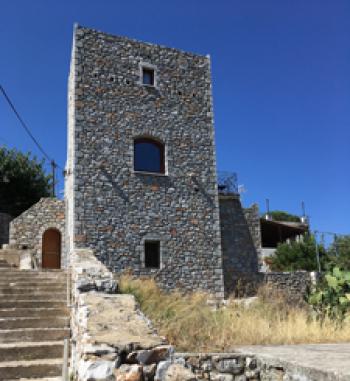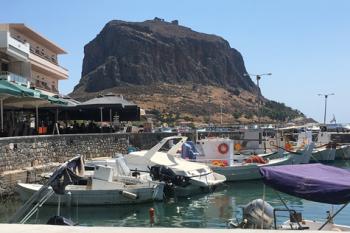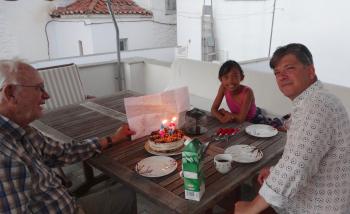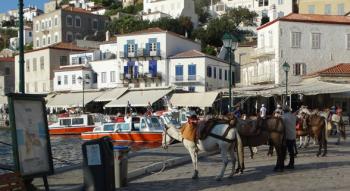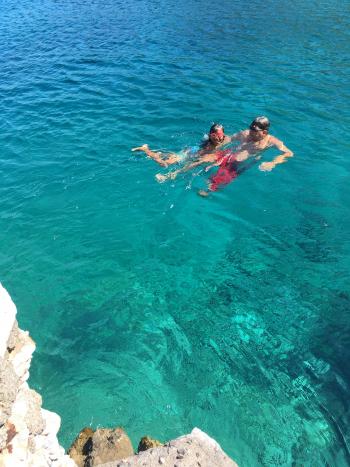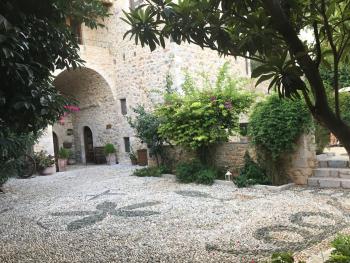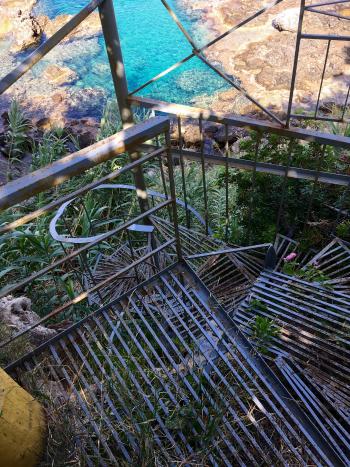Places to stay in Greece
This item appears on page 28 of the July 2019 issue.
My husband and I spent considerable time planning a June 27-July 26, 2018, trip to Greece, one that would avoid foreign tourists. Since we had visited Athens in 1984 (when there were only two other people at the Acropolis) and again in 2007 and had also visited a number of Greek islands, we wanted to experience the small villages of Greece (after a short trip to Athens).
We were joined on this trip by our son, Will, and his daughter, Cherise; our ages ranged from 86 down to 9. I would like to share the excellent places we stayed.
• In Athens, our Airbnb in a working-class neighborhood had a terrific front-window view of the Temple of Zeus and the Acropolis, a 5-minute walk away. Our host, Panos, met us at the door, showed us around the 2-bedroom apartment and made suggestions of nearby restaurants and sights.
We paid €604 (near $673) for four nights. You can find this apartment, listed as “Best Acropolis apt. view,” on Airbnb at www.airbnb.com/rooms/17186053.
We found all the rest of our lodgings on Booking.com.
• Life in Hydra, an island only a short ferry ride from Athens, is centered around the port, with many shops and restaurants, beaches with clear water, and memorials to the 1821 Greek Revolution.
The host of our apartment there met us and led us to a lovely house a 10-minute walk from the ferry landing. It cost €300 for two nights, and you can find it at www.booking.com/hotel/gr/vageli-39-s-house.en-gb.html.
The downstairs had a dining room, a living room, a bedroom and a patio with a washing machine and drying racks. The second floor held a large bedroom plus a covered patio with a table and chairs and fine views.
• Leaving Hydra, we picked up a car on the mainland to drive the Peloponnese to Nafplio, which was once the capital of Greece immediately after the 1821 revolution. Due to its strategic importance, the Byzantines, Franks, Venetians and Ottomans each ruled this pretty town at one point.
We stayed in the Old Town at the Polyxenia Hotel (4 Antonopoulon Str., Nafplio; phone +30 27520 97846 www.polyxeniahotel.gr), only a short block from city hall and owned by sisters Maria and Alexandria Dima. We had two rooms, and two nights cost €342, including an ample breakfast.
• The city of Leonidio sits in a wide valley at the mouth of the Badron Gorge, surrounded by high rocky escarpments. Our warm boutique hotel in a restored manor house, Hotel Hatzipanayiotis (Leonidio, Arkadia, PC 22300, Greece; phone +30 275 702 2476, www.hatzipanayiotis.gr/en), was built into a hill.
The bath and couch were downstairs, with bedrooms upstairs. The gardens and a large patio with swinging chairs, couches and a TV were lovely. While we watched the World Cup on the patio, older men were playing backgammon. Two cozy, air-conditioned rooms for two nights, breakfasts included, cost €319.
Located near bars and eateries, the hotel is 4 kilometers from Lakkos Beach and 16 kilometers from the Monastery of Elona.
• Monemvasia is a village built around an impregnable fortress on a huge rock across a narrow causeway from the mainland. It consists of medieval buildings, ruins and cobblestone walkways.
The town was established in the 6th century AD for protection from a Slavic invasion. The strategic site was fought over by the Byzantines, Franks (who built a castle), Venetians (who built the massive fortress) and Turks. It now has three Byzantine churches plus many boutique hotels in former grand old homes.
I won’t recommend our hotel there because I feel it was too expensive for what we got, but I can highly recommend the To Kanoni Restaurant (Main Square, Monemvasia Castle; phone +30 27320 61387, tokanoni.com), where we had a gourmet dinner on the terrace. Don’t miss the grilled tuna souvlaki (€26) and the orange cake (€5.90).
• Many tower-houses sprout from the town of Kokkala on the Mani Peninsula. Dating from around the 17th century, there are over 800 Maniot tower-houses on the peninsula, along with small churches and chapels with frescoes from as early as the 11th century. Don’t miss the drive to the southern end of the peninsula for a cove suitable for swimming near the ruins of the oracle of Poseidon.
Our hotel was the modernized Ampelos Tower, 50 steps up from a beach of white marble stones on a cove with blue to purple water. Our tower-house was very comfortable, with a king-sized bed in a loft and twin beds off the living room. The large front window framed the scenic cove and mountains.
Ampelos Tower can be booked at www.booking.com/hotel/gr/marathos-tower.en-gb.html. One night cost €90.
• Our hotel in Stoupa, Blue Lagoon (Tampourea St.; phone +30 6948 596762), looked out onto a green lawn ending at a shaded patio by a cliff down to the ocean, with a spiral staircase to access a lovely small cove. The hotel had a kitchenette and street parking, and we paid €180 for two nights.
The beach promenade in Stoupa is filled with shops and restaurants. Kastania, a nearby mountain village, has churches with Byzantine frescoes covering the walls.
• Our favorite town, however, was Dimitsana, with stone houses perched up the side of a gorge. We stayed at the Enastron Guesthouse (phone +30 27950 31684, www.xenonasenastron.gr/engl), where we had a suite with a king-sized bed and a loft with two twin beds. There was street parking. The view of the town and surrounding mountains was breathtaking.
For two nights, the two rooms cost €320, and our hostess made delicious cakes, egg sandwiches and jams for a very generous breakfast.
In Dimitsana, don’t miss the Open-Air Water Power Museum, which, along with excellent videos, shows how water power ran flour mills, felted wool for clothes and pounded saltpeter, sulfur and graphite to make gunpowder.
Except for the four nights in Athens and being able to reserve only one night in Kokkala, we spent two nights at each accommodation.
The driving time direct from place to place would have been only about 2½ hours, but our drives each took four to five hours, as we walked through villages, ate lunch, saw sights and went swimming. Most beaches have multitudes of umbrellas and tables to use if you buy refreshments. Most of the beaches are rocky, so it’s good to have water shoes.
For the few times breakfast was not included, we bought breakfast foodstuffs from a grocery store. Except for the gourmet dinner in Monemvasia, for lunch or dinner we paid between €15 and €55 total for the four of us.
Be sure to have a good GPS system because road signage is nearly nonexistent. The Greeks we met either spoke English quite well or only somewhat, but all could communicate effectively.
LINDA HUETINCK
Alhambra, CA

